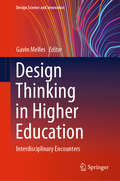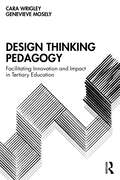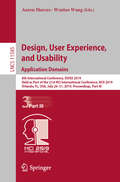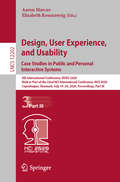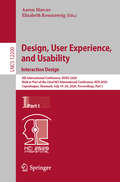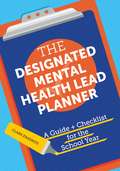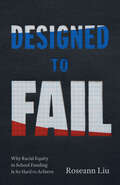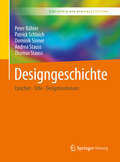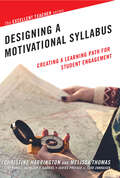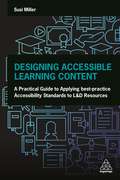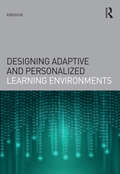- Table View
- List View
Design Thinking for Every Classroom: A Practical Guide for Educators
by Shelley Goldman Molly B. ZielezinskiDesigned to apply across grade levels, Design Thinking for Every Classroom is the definitive teacher’s guide to learning about and working with design thinking. Addressing the common hurdles and pain points, this guide illustrates how to bring collaborative, equitable, and empathetic practices into your teaching. Learn about the innovative processes and mindsets of design thinking, how it differs from what you already do in your classroom, and steps for integrating design thinking into your own curriculum. Featuring vignettes from design thinking classrooms alongside sample lessons, assessments and starter activities, this practical resource is essential reading as you introduce design thinking into your classroom, program, or community.
Design Thinking for Every Classroom: A Practical Guide for Educators
by Shelley Goldman Molly B. ZielezinskiDesigned to apply across grade levels, Design Thinking for Every Classroom is the definitive teacher’s guide to learning about and working with design thinking. Addressing the common hurdles and pain points, this guide illustrates how to bring collaborative, equitable, and empathetic practices into your teaching. Learn about the innovative processes and mindsets of design thinking, how it differs from what you already do in your classroom, and steps for integrating design thinking into your own curriculum. Featuring vignettes from design thinking classrooms alongside sample lessons, assessments and starter activities, this practical resource is essential reading as you introduce design thinking into your classroom, program, or community.
Design Thinking for New Business Contexts: A Critical Analysis through Theory and Practice
by David Hands Yujia HuangThis textbook identifies and critically explores the new business landscape through the lens of design thinking and contemporary industry practice, bridging the divide between the design and business domains. The book outlines the evolution of design thinking and the relationship between business and design, as well as provides in-depth studies of design thinking in turbulent business contexts, that includes the themes of sustainability, branding and organisational innovation. At its core, it articulates that design thinking is vital to establishing dynamic interdisciplinary thinking models that lead to organizational innovation. Featuring case studies and learning tasks, the book presents design thinking for readers as an organisational philosophy as opposed to a simple problem-solving tool.
Design Thinking for Smaller Enterprise Development: a SOCIETALbyDesign Model for Adaptation to a Digital Age
by Adina TarryDesign Thinking for Smaller Enterprise Development captures the zeitgeist and concerns of the new Millennium and offers a fresh view on how business can be successful by benefiting the wider society it should serve. It also highlights the systemic negative impact of a consumption and profit-focussed economy and introduces an original model – SOCIETALByDesign™ – as a constructive alternative to relentless resource depletion, through an agile, adaptive, and respectful enterprise, which protects nature and civilisation and embraces a balanced and holistic purpose to serve people, planet and a positive legacy, as the heart of its very reason of being. The original SOCIETALByDesign™ model positions purpose, principles, framework and current techniques for a modern business to utilise and holistically integrate benefits for employees, society and environment thought its products and services. The SOCIETALByDesign™ model links purpose and business and synthesises an operating model that can be adopted, adapted and applied by any enterprise wishing to focus on shared prosperity and the good of people and planet instead of profit at any price. The book is intended for business practitioners such as business founders and owners, angel investors, entrepreneurs, portfolio managers of investment funds, managers and leaders of companies large and small. It is also helpful for external business and organisation development consultants, mentors, coaches and specialists who provide services and expertise to enterprises design, change and optimisation. Because the book provides a practitioner’s perspective on business, it can also be useful to students, lecturers and academics.
Design Thinking for Smaller Enterprise Development: a SOCIETALbyDesign Model for Adaptation to a Digital Age
by Adina TarryDesign Thinking for Smaller Enterprise Development captures the zeitgeist and concerns of the new Millennium and offers a fresh view on how business can be successful by benefiting the wider society it should serve. It also highlights the systemic negative impact of a consumption and profit-focussed economy and introduces an original model – SOCIETALByDesign™ – as a constructive alternative to relentless resource depletion, through an agile, adaptive, and respectful enterprise, which protects nature and civilisation and embraces a balanced and holistic purpose to serve people, planet and a positive legacy, as the heart of its very reason of being. The original SOCIETALByDesign™ model positions purpose, principles, framework and current techniques for a modern business to utilise and holistically integrate benefits for employees, society and environment thought its products and services. The SOCIETALByDesign™ model links purpose and business and synthesises an operating model that can be adopted, adapted and applied by any enterprise wishing to focus on shared prosperity and the good of people and planet instead of profit at any price. The book is intended for business practitioners such as business founders and owners, angel investors, entrepreneurs, portfolio managers of investment funds, managers and leaders of companies large and small. It is also helpful for external business and organisation development consultants, mentors, coaches and specialists who provide services and expertise to enterprises design, change and optimisation. Because the book provides a practitioner’s perspective on business, it can also be useful to students, lecturers and academics.
Design Thinking im Bildungsmanagement: Innovationen in Bildungskontexten erfolgreich entwickeln und umsetzen
by Iris Schmidberger Sven Wippermann Tobias Stricker Ulrich MüllerDer vorliegende Sammelband eröffnet sowohl theoretische als auch praxisorientierte Perspektiven auf Design Thinking in Bildungskontexten. Die internationalen Beiträge geben Einblicke in unterschiedliche Nutzungsmöglichkeiten der zielgruppenzentrierten Innovationsmethodologie im Bildungsbereich - von Schule über Hochschule und Weiterbildung bis hin zur betrieblichen Organisationsentwicklung - und unterstützen so die erfolgreiche Initiierung und Umsetzung von Innovationen im Bildungsmanagement.
Design Thinking in Cultural and Heritage Management: Creating Solutions in the Field of Culture (ISSN)
by Lubomira Trojan Łukasz WróblewskiThe ability to discover and respond to societal needs in the field of culture requires an integrated, interdisciplinary, and cross-sectoral approach. Such a holistic view is offered by the design thinking method, which has been extracted from the field of design and could be applied also in the sphere of culture. Interdisciplinarity and consideration of users' needs are characteristics of contemporary design and can be a significant support when faced with the challenges of cultural heritage management. The abovementioned factors act as the premise behind undertaking an analysis of the possibility of adapting the design thinking method to the management of intangible cultural heritage, and to develop a model of the design thinking process for this area. This research volume is the first comprehensive study of the application of the design thinking method to cultural management, especially management of the intangible cultural heritage. It asserts that design thinking can bring numerous benefits to organizations involved in the management of intangible cultural heritage and to its depositories. It will be of interest to researchers and academics in the fields of public and nonprofit management, strategic management, and value creation in the field of culture; students of design for culture and heritage; and practitioners in cultural management.
Design Thinking in Cultural and Heritage Management: Creating Solutions in the Field of Culture (ISSN)
by Lubomira Trojan Łukasz WróblewskiThe ability to discover and respond to societal needs in the field of culture requires an integrated, interdisciplinary, and cross-sectoral approach. Such a holistic view is offered by the design thinking method, which has been extracted from the field of design and could be applied also in the sphere of culture. Interdisciplinarity and consideration of users' needs are characteristics of contemporary design and can be a significant support when faced with the challenges of cultural heritage management. The abovementioned factors act as the premise behind undertaking an analysis of the possibility of adapting the design thinking method to the management of intangible cultural heritage, and to develop a model of the design thinking process for this area. This research volume is the first comprehensive study of the application of the design thinking method to cultural management, especially management of the intangible cultural heritage. It asserts that design thinking can bring numerous benefits to organizations involved in the management of intangible cultural heritage and to its depositories. It will be of interest to researchers and academics in the fields of public and nonprofit management, strategic management, and value creation in the field of culture; students of design for culture and heritage; and practitioners in cultural management.
Design Thinking in Education: Innovation Can Be Learned
by Christoph Meinel Timm KrohnEducation needs new ways to prepare individuals and societies for the multitude of changing challenges in the twenty-first century. In today's world—characterized by digitization, increasing speed, and complexity—design thinking has established itself as a powerful approach to human-centered innovation that can help address complicated problems and guide change in all areas of life. Design thinking formats not only teach skills that benefit people as they expand their "toolbox," but also create affective and cognitive outcomes. This book includes experiences, approaches, and reflections on design thinking in education from different perspectives of renowned design thinking experts from the network of the Hasso Plattner Institute and its School of Design Thinking. Using real-world examples, the book provides insights into requirements and protocols that design thinking practitioners can apply to transform their academic or professional ecosystem. It will be of interest for readers who work in or are interested in a wide variety of educational contexts.
Design Thinking in Higher Education: Interdisciplinary Encounters (Design Science and Innovation)
by Gavin MellesThis book addresses the contributions of design thinking to higher education and explores the benefits and challenges of design thinking discourses and practices in interdisciplinary contexts. With a particular focus on Australia, the USA and UK, the book examines the value and drawbacks of employing design thinking in different disciplines and contexts, and also considers its future.
Design Thinking in Student Affairs: A Primer
by Julia Allworth Lesley D'Souza Gavin W. HenningDesign thinking is an innovative problem-solving framework. This introduction is the first book to apply its methodology to student affairs and, in doing so, points the way to its potentially wider value to higher education as a whole.With its focus on empathy, which is the need to thoroughly understand users’ experiences, design thinking is user-centered, similar to how student affairs is student-centered. Because the focus of design thinking is to design with users, not for users, it aligns well with student affairs practice. In addition, its focus on empathy makes design thinking a more equitable approach to problem-solving than other methods because all users’ experiences—not just the experiences of majority or “average” student—need to be understood. Centering empathy in problem-solving processes can be a tool to disrupt higher education systems and practices.Design thinking is a framework to foster innovation, and, by its nature, innovation is about responding to change factors with creativity. In an organization, design thinking is inherently connected to organizational change and culture because the process is really about changing people to help them rally around a disruptive idea. Implementing design thinking on a campus may in itself be disruptive and require a change management process. The beauty of using design thinking is that it can also act as a framework to support organizational culture change.Design thinking approaches, with their focus on stakeholder needs (as opposed to systemic norms), collaborative solutions building, and structured empathy activities can offer a concrete tool to disrupt harmful systems of power and oppression. Design thinking as a process is not a magic solution to equity problems, though it can be a powerful tool to approach the development of solutions that can address inequity. Design thinking is data-driven and considers both qualitative and quantitative data as necessary to gain most complete picture of an issue and its possible solutions, whether a product, program, or service.Design thinking has numerous benefits to afford students affairs. Chapter 1 outlines a case for design thinking in student affairs. Chapter 2 discusses a brief history of design thinking, noting its germination and evolution to current practice. Chapter 3 provides a detailed description of each step of the design thinking model with pertinent examples to make the steps clearer. Chapter 4 explains the intersection of equity and design thinking while chapter 5 explores the use of design thinking for organizational change. Chapter 6 presents a new model for design thinking assessment. Chapter 7 addresses the challenges and limitations of the process. Chapter 8 concludes the book by discussing the alignment of design thinking and student affairs and outlining next steps.Design thinking is an innovative process that can change the way higher education and student affairs operates, realizing the potential it offers.
Design Thinking in Student Affairs: A Primer
by Julia Allworth Lesley D'Souza Gavin W. HenningDesign thinking is an innovative problem-solving framework. This introduction is the first book to apply its methodology to student affairs and, in doing so, points the way to its potentially wider value to higher education as a whole.With its focus on empathy, which is the need to thoroughly understand users’ experiences, design thinking is user-centered, similar to how student affairs is student-centered. Because the focus of design thinking is to design with users, not for users, it aligns well with student affairs practice. In addition, its focus on empathy makes design thinking a more equitable approach to problem-solving than other methods because all users’ experiences—not just the experiences of majority or “average” student—need to be understood. Centering empathy in problem-solving processes can be a tool to disrupt higher education systems and practices.Design thinking is a framework to foster innovation, and, by its nature, innovation is about responding to change factors with creativity. In an organization, design thinking is inherently connected to organizational change and culture because the process is really about changing people to help them rally around a disruptive idea. Implementing design thinking on a campus may in itself be disruptive and require a change management process. The beauty of using design thinking is that it can also act as a framework to support organizational culture change.Design thinking approaches, with their focus on stakeholder needs (as opposed to systemic norms), collaborative solutions building, and structured empathy activities can offer a concrete tool to disrupt harmful systems of power and oppression. Design thinking as a process is not a magic solution to equity problems, though it can be a powerful tool to approach the development of solutions that can address inequity. Design thinking is data-driven and considers both qualitative and quantitative data as necessary to gain most complete picture of an issue and its possible solutions, whether a product, program, or service.Design thinking has numerous benefits to afford students affairs. Chapter 1 outlines a case for design thinking in student affairs. Chapter 2 discusses a brief history of design thinking, noting its germination and evolution to current practice. Chapter 3 provides a detailed description of each step of the design thinking model with pertinent examples to make the steps clearer. Chapter 4 explains the intersection of equity and design thinking while chapter 5 explores the use of design thinking for organizational change. Chapter 6 presents a new model for design thinking assessment. Chapter 7 addresses the challenges and limitations of the process. Chapter 8 concludes the book by discussing the alignment of design thinking and student affairs and outlining next steps.Design thinking is an innovative process that can change the way higher education and student affairs operates, realizing the potential it offers.
Design Thinking Pedagogy: Facilitating Innovation and Impact in Tertiary Education
by Cara Wrigley Genevieve MoselyThe problems facing society today are complex, multifaceted, and require crossing multiple disciplinary boundaries. As such, these problems call for interdisciplinary collaboration, including new and different combinations of skills and knowledge. Currently, tertiary education providers are not well-positioned to develop these interdisciplinary capabilities at a rate commensurate with the speed of contemporary change. This book places design thinking as the catalyst to create change in the tertiary education sector and to build interdisciplinary skill sets that are required for the graduate of the future. By presenting a series of case studies and drawing on global experts in the field, this book investigates pedagogical approaches, disciplinary facilitation practice, curriculum integration, and a framework for understanding design thinking pedagogy within tertiary education. Focusing on how educational institutions can produce innovative graduates with the ability to traverse disciplinary constraints, this book will be essential reading for research students, academics, and industry practitioners.
Design Thinking Pedagogy: Facilitating Innovation and Impact in Tertiary Education
by Cara Wrigley Genevieve MoselyThe problems facing society today are complex, multifaceted, and require crossing multiple disciplinary boundaries. As such, these problems call for interdisciplinary collaboration, including new and different combinations of skills and knowledge. Currently, tertiary education providers are not well-positioned to develop these interdisciplinary capabilities at a rate commensurate with the speed of contemporary change. This book places design thinking as the catalyst to create change in the tertiary education sector and to build interdisciplinary skill sets that are required for the graduate of the future. By presenting a series of case studies and drawing on global experts in the field, this book investigates pedagogical approaches, disciplinary facilitation practice, curriculum integration, and a framework for understanding design thinking pedagogy within tertiary education. Focusing on how educational institutions can produce innovative graduates with the ability to traverse disciplinary constraints, this book will be essential reading for research students, academics, and industry practitioners.
Design, User Experience, and Usability. Application Domains: 8th International Conference, DUXU 2019, Held as Part of the 21st HCI International Conference, HCII 2019, Orlando, FL, USA, July 26–31, 2019, Proceedings, Part III (Lecture Notes in Computer Science #11585)
by Aaron Marcus Wentao WangThe four-volume set LNCS 11583, 11584, 11585, and 11586 constitutes the proceedings of the 8th International Conference on Design, User Experience, and Usability, DUXU 2019, held as part of the 21st International Conference, HCI International 2019, which took place in Orlando, FL, USA, in July 2019.The total of 1274 papers and 209 posters included in the 35 HCII 2019 proceedings volumes was carefully reviewed and selected from 5029 submissions.DUXU 2019 includes a total of 167 regular papers, organized in the following topical sections: design philosophy; design theories, methods, and tools; user requirements, preferences emotions and personality; visual DUXU; DUXU for novel interaction techniques and devices; DUXU and robots; DUXU for AI and AI for DUXU; dialogue, narrative, storytelling; DUXU for automated driving, transport, sustainability and smart cities; DUXU for cultural heritage; DUXU for well-being; DUXU for learning; user experience evaluation methods and tools; DUXU practice; DUXU case studies.
Design, User Experience, and Usability. Case Studies in Public and Personal Interactive Systems: 9th International Conference, DUXU 2020, Held as Part of the 22nd HCI International Conference, HCII 2020, Copenhagen, Denmark, July 19–24, 2020, Proceedings, Part III (Lecture Notes in Computer Science #12202)
by Aaron Marcus Elizabeth RosenzweigThis book constitutes the refereed proceedings of the 9th International Conference on Design, User Experience, and Usability, DUXU 2020, held as part of the 22nd International Conference on Human-Computer Interaction, HCII 2020, in Copenhagen, Denmark, in July 2020. The conference was held virtually due to the COVID-19 pandemic. From a total of 6326 submissions, a total of 1439 papers and 238 posters has been accepted for publication in the HCII 2020 proceedings. The 51 papers included in this volume were organized in topical sections on interactions in public, urban and rural contexts; UX design for health and well-being; DUXU for creativity, learning and collaboration; DUXU for culture and tourism.
Design, User Experience, and Usability. Interaction Design: 9th International Conference, DUXU 2020, Held as Part of the 22nd HCI International Conference, HCII 2020, Copenhagen, Denmark, July 19–24, 2020, Proceedings, Part I (Lecture Notes in Computer Science #12200)
by Aaron Marcus Elizabeth RosenzweigThis book constitutes the refereed proceedings of the 9th International Conference on Design, User Experience, and Usability, DUXU 2020, held as part of the 22nd International Conference on Human-Computer Interaction, HCII 2020, in Copenhagen, Denmark, in July 2020. The conference was held virtually due to the COVID-19 pandemic.From a total of 6326 submissions, a total of 1439 papers and 238 posters has been accepted for publication in the HCII 2020 proceedings. The 40 papers included in this volume were organized in topical sections on UX design methods, tools and guidelines, interaction design and information visualization, and emotional design.
The Designated Mental Health Lead Planner: A Guide and Checklist for the School Year
by Clare ErasmusThis planner provides detailed guidance on what a Designated Mental Health Lead needs to do, when they need to do it, and how they can achieve the best results. It gives a clear focus and checklist for each week, including spaces to add your own to-do list, and encourages reflection on the outcomes and impact of your actions on pupils' attainment and wellbeing. It also encourages a focus on your own development and self-care, with space to record what you are currently reading or listening to and one thing you are grateful for that week.In addition to the termly and weekly plans, the book provides short briefs on key aspects of the role, including how to work effectively with teachers, the HR team, the DSL, governors, the pastoral team, Mental Health Support Teams and parents. It is an invaluable resource for all DMHLs tackling the 39 academic weeks.
Designed to Fail: Why Racial Equity in School Funding Is So Hard to Achieve
by Roseann LiuA provocative examination of how systemic racism in education funding is sustained. For people who care about urban school districts like Philadelphia’s, addressing the challenges that these schools face often boils down to the need for more money. But why are urban districts that serve Black and Brown students still so perennially underfunded compared to majority-white ones? Why is racial equity in school funding so hard to achieve? In Designed to Fail, Roseann Liu provides an inside look at the Pennsylvania state legislature and campaigns for fair funding to show how those responsible for the distribution of school funding work to maintain the privileges of majority-white school districts. Liu analyzes how colorblind policies, political structures, and the maintenance of the status quo by people in power perpetuate wide and deepening racial disparities in education funding. Taking a lesson from community organizers fighting for a racially equitable school funding system, Liu’s work is a bold call to address structural racism at the root and organize from a place of abundant justice.
Designgeschichte: Epochen – Stile – Designtendenzen (Bibliothek der Mediengestaltung)
by Peter Bühler Patrick Schlaich Dominik Sinner Andrea Stauss Thomas StaussTauchen Sie mit diesem Buch tief in die Designgeschichte ein Sie sind auf der Suche nach einem soliden Nachschlagewerk über die Designgeschichte? Sie möchten Ihr Verständnis für die Entwicklungshintergründe der Stile und Epochen sensibilisieren? Dann darf dieser Band aus der „Bibliothek der Mediengestaltung“ in Ihrem Bücherregal nicht fehlen. Die Autoren nehmen Sie mit auf eine Zeitreise durch wichtige Kunstepochen - vom vorgeschichtlichen Design bis heute. Erfahren Sie mehr über: • Gotik • Barock • Biedermeier • Arts-and-Crafts-Bewegung • Bauhaus • Pop-Design Dieses Buch vermittelt Grundwissen und -begriffen und zeigt Ihnen, wie Sie Designtendenzen und epochentypische Merkmale bestimmen, die unsere Gesellschaft zum Teil bis heute prägen. Ein hilfreiches Nachschlagewerk für viele Zielgruppen Mit vielen Aufgaben und Musterlösungen am Ende der Kapitel überprüfen Sie Ihren Lernfortschritt. Dadurch vereint dieses Werk nachhaltig Theorie und Praxis und bereitet Sie optimal auf Prüfungen in Studiengängen und Ausbildungen rund um die gängigen Print- und Digitalmedien vor.
Designing a Motivational Syllabus: Creating a Learning Path for Student Engagement
by Christine Harrington Melissa ThomasA thoughtfully constructed syllabus can be transformative for your students’ learning, communicating the path they can take to succeed. This book demonstrates how, rather than being a mundane document to convey policies, you can construct your syllabus to be a motivating resource that conveys a clear sense of your course’s learning goals, how students can achieve those goals, and makes evident your teaching philosophy and why you have adopted the teaching strategies you will use, such as discussion or group activities. Developing or revising a syllabus also presents you with a perfect opportunity to review the learning possibilities for the semester. Well-designed, it can help you stay focused on achieving the learning outcomes, as well as determine if the class is on track and whether adjustments to the schedule are needed. The authors show how, by adopting a welcoming tone and clearly stating learning outcomes, your syllabus can engage students by explaining the relevance of your course to their studies, create an all-important positive first impression of you as an instructor, and guide students through the resources you will be using, the assignments ahead, as well as clear guidance on how they will be assessed. Referred to frequently as the course progresses, an effective syllabus will keep students engaged and on task.Christine Harrington and Melissa Thomas lead you through all the elements of a syllabus to help you identify how to present key messages and information about your course, think through the impressions you want to create, and, equally importantly, suggest how you can use layout and elements such as images and charts to make your syllabus visually appealing and easy to navigate.
Designing a Motivational Syllabus: Creating a Learning Path for Student Engagement
by Christine Harrington Melissa ThomasA thoughtfully constructed syllabus can be transformative for your students’ learning, communicating the path they can take to succeed. This book demonstrates how, rather than being a mundane document to convey policies, you can construct your syllabus to be a motivating resource that conveys a clear sense of your course’s learning goals, how students can achieve those goals, and makes evident your teaching philosophy and why you have adopted the teaching strategies you will use, such as discussion or group activities. Developing or revising a syllabus also presents you with a perfect opportunity to review the learning possibilities for the semester. Well-designed, it can help you stay focused on achieving the learning outcomes, as well as determine if the class is on track and whether adjustments to the schedule are needed. The authors show how, by adopting a welcoming tone and clearly stating learning outcomes, your syllabus can engage students by explaining the relevance of your course to their studies, create an all-important positive first impression of you as an instructor, and guide students through the resources you will be using, the assignments ahead, as well as clear guidance on how they will be assessed. Referred to frequently as the course progresses, an effective syllabus will keep students engaged and on task.Christine Harrington and Melissa Thomas lead you through all the elements of a syllabus to help you identify how to present key messages and information about your course, think through the impressions you want to create, and, equally importantly, suggest how you can use layout and elements such as images and charts to make your syllabus visually appealing and easy to navigate.
Designing Accessible Learning Content: A Practical Guide to Applying best-practice Accessibility Standards to L&D Resources
by Susi MillerMaking learning and development (L&D) content inclusive and accessible for everyone is not only a good thing to do, it's the right thing to do. Designing Accessible Learning Content provides evidence-based advice on designing digital learning content that ensures all learners are included and are therefore able to perform to their full potential.This is a practical guide on accessibility for anyone involved in the design, creation, development or testing of online learning content. It provides detailed guidance on how to meet the Web Content Accessibility Guidelines making it essential reading for L&D professionals, instructional designers and course developers who need to comply with legal accessibility requirements. Using the author's 'eLearning Accessibility Framework', Designing Accessible Learning Content demystifies sometimes complex technical accessibility standards and provides an easy to follow contextual framework uniquely designed for learning content created using any authoring tool.This book also demonstrates how creating accessible learning content can improve usability and provide the best possible learning experience for everyone. In addition, it offers essential background information such as a focus on disability, an overview of assistive technology and an exploration of the case for digital accessibility. This guarantees that L&D professionals have the vital background knowledge they need to make sense of accessibility before they begin practically applying the principles. With online checklists, learner case studies, and industry perspectives, Designing Accessible Content is an essential handbook for all L&D professionals seeking to harness the benefits of accessibility in order to improve their learning content for everyone.
Designing Adaptive and Personalized Learning Environments (Interdisciplinary Approaches to Educational Technology)
by KinshukDesigning Adaptive and Personalized Learning Environments provides a theoretically-based yet practical guide to systematic design processes for learning environments that provide automatic customization of learning and instruction. The book consists of four main sections: In "Introduction and Overview," the concepts of adaptivity and personalization are introduced and explored in detail. In "Theoretical Perspectives with Example Applications," various theoretical concepts underlying adaptive and personalized learning are discussed, including cognitive profiling, content-based adaptivity, exploration-based adaptivity, and mobile and ubiquitous settings. In "Practical Perspectives with Example Applications," the implementation process for adaptive and personalized learning environments is described, followed by application in various contexts. In "Validation and Future Trends," various evaluation techniques for validating the efficiency and efficacy of adaptive and personalized learning systems are discussed. This final section concludes with a discussion of emerging trends in adaptive and personalized learning research. Based on cutting-edge research, Designing Adaptive and Personalized Learning Environments is appropriate as a primary textbook for both undergraduate and graduate courses focused on the design of learning systems, and as a secondary textbook for a variety of courses in programs such as educational technology, instructional design, learning sciences, digital literacy, computer based systems, and STEM content fields.
Designing Adaptive and Personalized Learning Environments (Interdisciplinary Approaches to Educational Technology)
by KinshukDesigning Adaptive and Personalized Learning Environments provides a theoretically-based yet practical guide to systematic design processes for learning environments that provide automatic customization of learning and instruction. The book consists of four main sections: In "Introduction and Overview," the concepts of adaptivity and personalization are introduced and explored in detail. In "Theoretical Perspectives with Example Applications," various theoretical concepts underlying adaptive and personalized learning are discussed, including cognitive profiling, content-based adaptivity, exploration-based adaptivity, and mobile and ubiquitous settings. In "Practical Perspectives with Example Applications," the implementation process for adaptive and personalized learning environments is described, followed by application in various contexts. In "Validation and Future Trends," various evaluation techniques for validating the efficiency and efficacy of adaptive and personalized learning systems are discussed. This final section concludes with a discussion of emerging trends in adaptive and personalized learning research. Based on cutting-edge research, Designing Adaptive and Personalized Learning Environments is appropriate as a primary textbook for both undergraduate and graduate courses focused on the design of learning systems, and as a secondary textbook for a variety of courses in programs such as educational technology, instructional design, learning sciences, digital literacy, computer based systems, and STEM content fields.






